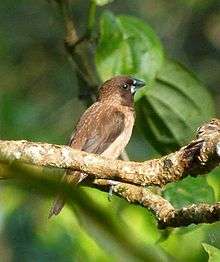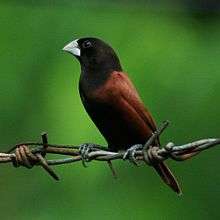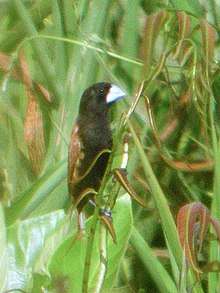Lonchura
Lonchura is a genus of the estrildid finch family, and includes munias (or minias), mannikins, and silverbills. They are resident breeding birds in Africa and in South Asia from India, Bangladesh, Sri Lanka east to Indonesia, Papua New Guinea, and the Philippines. Two of the approximately thirty-seven species are also native to Australia. The name mannikin is from Middle Dutch mannekijn 'little man' (also the source of the different bird name manakin).[1]
| Munia | |
|---|---|
 | |
| Chestnut-breasted munia Lonchura castaneothorax | |
| Scientific classification | |
| Kingdom: | Animalia |
| Phylum: | Chordata |
| Class: | Aves |
| Order: | Passeriformes |
| Family: | Estrildidae |
| Genus: | Lonchura Sykes, 1832 |
| Species | |
|
See text | |
Some of the Lonchura species were formerly placed in Spermestes. Others have been placed in a genus of their own, Euodice.
Taxonomy
The genus Lonchura was introduced by the English naturalist William Henry Sykes in 1832.[2] The type species was subsequently designated as the scaly-breasted munia.[3] The name Lonchura combines the Ancient Greek words lonkhē "spear-head" or "lance" with oura "tail".[4]
Characteristics
They are small gregarious birds which feed mainly on seeds, usually in relatively open habitats, preferring to feed on the ground or on reeds of grasses. Several species have been noted to feed on algae such as Spirogyra.[5][6]
The nest is a large domed grass structure into which four to ten white eggs are laid. Some species also build communal roosting nests for overnight rest.
The species in this genus are similar in size and structure, with stubby bills, stocky bodies and long tails. Most are 10–12 cm in length. Plumage is usually a combination of browns, black and white, with the sexes similar, but duller and less contrasted for immature birds.
The similarities within this group and the existence of subspecies with differing vocalisations and plumage mean that some races may be elevated to species status. African and Indian silverbill are now usually considered distinct species, and the two races of black-throated munia are often also split.
The munias are popular in the bird trade and many freed or escaped birds have formed feral colonies in different pockets across the world.
The red munia Amandava amandava and green munia Amandava formosa also take the name munia, but are in the genus Amandava.
Species
The genus contains 35 species:[7]
| Image | Common Name | Scientific name | Distribution |
|---|---|---|---|
%2C_crop.jpg) | Bronze mannikin also known as bronze munia | Lonchura cucullata | Afrotropics. |
_(7699911414)%2C_crop.jpg) | Black-and-white mannikin also known as black-and-white munia | Lonchura bicolor | western and central Africa |
.jpg) | Red-backed mannikin also known as brown-backed munia | Lonchura nigriceps | Angola, The Democratic Republic of the Congo, Kenya, Malawi, Mozambique, Somalia, South Africa, Swaziland, Tanzania, Zambia and Zimbabwe. |
 | Magpie mannikin also known as magpie munia | Lonchura fringilloides | Sub-Saharan Africa. |
 | White-rumped munia | Lonchura striata | the Indian subcontinent to southern China east to Taiwan, and through Southeast Asia south to Sumatra |
 | Javan munia | Lonchura leucogastroides | Southern Sumatra, Java, Bali and Lombok, Indonesia. Introduced in Singapore and S Malay Peninsula |
 | Dusky munia | Lonchura fuscans | Borneo |
_(cropped).jpg) | Black-faced munia | Lonchura molucca | Indonesia |
.jpg) | Scaly-breasted munia also known as nutmeg mannikin or spice finch | Lonchura punctulata | Indian Subcontinent, including Pakistan, India, Nepal, Bangladesh and Sri Lanka |
 | Black-throated munia also known as Jerdon's mannikin | Lonchura kelaarti | southwest India, the Eastern Ghats and Sri Lanka. |
| White-bellied munia | Lonchura leucogastra | Malesia. | |
| Streak-headed mannikin | Lonchura tristissima | New Guinea | |
| White-spotted mannikin | Lonchura leucosticta | New Guinea. | |
| Five-colored munia | Lonchura quinticolor | Lesser Sunda Islands. | |
 | Tricolored munia | Lonchura malacca | Bangladesh,[2] India, Sri Lanka, and southern China. |
| White-capped munia | Lonchura ferruginosa | Java and Bali | |
 | Chestnut munia | Lonchura atricapilla | Bangladesh, Brunei, Cambodia, China, India, Indonesia, Laos, Malaysia, Burma, Nepal, Philippines, Singapore, Taiwan, Thailand, Vietnam and Hawaii. |
.jpg) | White-headed munia | Lonchura maja | Indonesia, Malaysia, Singapore, Thailand and Vietnam. |
.jpg) | Pale-headed munia | Lonchura pallida | Indonesia. |
 | Great-billed mannikin | Lonchura grandis | northern and eastern New Guinea. |
| Grey-banded mannikin | Lonchura vana | north-west Papua, Indonesia | |
.jpg) | Grey-headed mannikin | Lonchura caniceps | Papua |
| Grey-crowned mannikin | Lonchura nevermanni | southern New Guinea | |
| Hooded mannikin | Lonchura spectabilis | New Britain and New Guinea. | |
| Forbes's mannikin | Lonchura forbesi | Papua New Guinea | |
| Hunstein's mannikin | Lonchura hunsteini | New Ireland and New Hannover. | |
| Yellow-rumped mannikin | Lonchura flaviprymna | Northern Territory, Australia | |
| Chestnut-breasted mannikin | Lonchura castaneothorax | Australia, New Caledonia, Indonesia, and Papua New Guinea. | |
| Black mannikin | Lonchura stygia | New Guinea, Papua, Papua New Guinea. | |
| Black-breasted mannikin | Lonchura teerinki | West Papua, Indonesia. | |
| Eastern alpine mannikin | Lonchura monticola | Papua | |
| Western alpine mannikin | Lonchura montana | New Guinea | |
| Buff-bellied mannikin | Lonchura melaena | New Britain and Buka Island. | |
| Timor sparrow | Lonchura fuscata | Timor archipelago | |
.jpg) | Java sparrow | Lonchura oryzivora | Java, Bali and Bawean in Indonesia |
Notes
- New Oxford American Dictionary (2nd ed., 2005), p. 1032.
- Sykes, William Henry (1832). "Catalogue of birds of the raptorial and insessorial orders (systematically arranged,) observed in the Dukhun". Proceedings of the Zoological Society of London. 2 (18): 77-99 [94].
- Dickinson, E.C.; Christidis, L., eds. (2014). The Howard & Moore Complete Checklist of the Birds of the World. Volume 2: Passerines (4th ed.). Eastbourne, UK: Aves Press. p. 297. ISBN 978-0-9568611-2-2.
- Jobling, J.A. (2018). del Hoyo, J.; Elliott, A.; Sargatal, J.; Christie, D.A.; de Juana, E. (eds.). "Key to Scientific Names in Ornithology". Handbook of the Birds of the World Alive. Lynx Edicions. Retrieved 2 May 2018.
- Pillai, N. G. 1968 The green algae, Spirogyra sp., in the diet of the White-backed Munia, Lonchura striata (Linn.). J. Bombay Nat. Hist. Soc. 65: 490-491
- Avery, Michael L. (1980) Diet and breeding seasonality among a population of sharp-tailed munias, Lonchura striata in Malaysia. The Auk 97(1):160-166
- Gill, Frank; Donsker, David, eds. (2018). "Waxbills, parrotfinches, munias, whydahs, Olive Warbler, accentors, pipits". World Bird List Version 8.1. International Ornithologists' Union. Retrieved 2 May 2018.
References
| Wikimedia Commons has media related to Lonchura. |
- Birds of India by Grimmett, Inskipp and Inskipp, ISBN 0-691-04910-6
- Birds of The Gambia by Barlow, Wacher and Disley, ISBN 1-873403-32-1